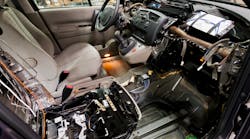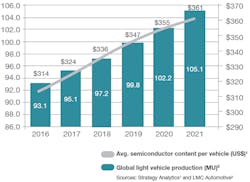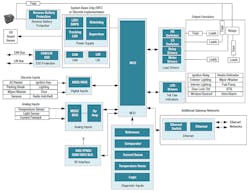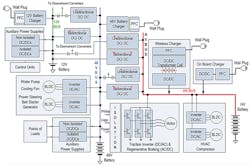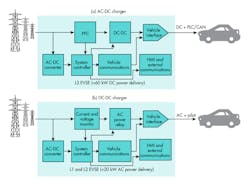More Electrification Means Greater Automobile Efficiency
Download this article in PDF format.
Automotive designers have been replacing mechanical components with electric alternatives almost since the first horseless carriage caused consternation in horse-drawn traffic and pedestrians alike. The earliest vehicles, for example, used kerosene lamps for lighting, but they didn’t last long—the first electric light for vehicles came out in 1906. More recent innovations have included high-intensity lighting (HID), LED lamps, and auto-leveling headlights. A similar pattern is found across the vehicle: The steady replacement of mechanical functions by their electronic equivalents.
Several factors are driving the switch from mechanical to electronic technology. Electronic solutions tend to increase the complexity and perhaps cost of the design, but they offer higher performance, higher efficiency, smaller size, and lower weight. They also allow designers to include features that aren’t feasible, or even possible, with mechanical designs.
Sponsored Resources:
- Taking charge of electric vehicles – both in the vehicle and on the grid
- Driving the green revolution in transportation
- Evolution vs. revolution: the building blocks of automotive body electronics
As a result, the number of electronic modules has shown a slow-but-steady increase over several decades. The per-vehicle semiconductor content by value has also risen, despite the plummeting cost of individual components. As shown in Figure 1, this trend is expected to continue.
1. The per-vehicle semiconductor content is forecast to continue its steady ramp-up.
Let’s take a look at two areas—body electronics and powertrain—and see how each have benefited from increased electrification, some of the changes we can expect to see over the next few years, and how TI products help pave the way.
Body Electronics Enhances the Driving Environment
The body-electronics category includes many comfort and convenience features such as electric seats, mirrors, interior and exterior lighting, remote keyless entry (RKE), washers, wipers, window, and sunroof controls. These are often grouped together into an integrated body electronics controller (Fig. 2).
2. The Body Control Module (BCM) includes many comfort and convenience features (Source: TI: “Evolution vs. revolution: the building blocks of automotive body electronics” PDF)
The automotive market is high volume, so manufacturers have developed automotive-qualified application-specific integrated circuits (ASICs), or system-on-chip (SoC) devices, for many functions. In body electronics, Texas Instruments offers such devices as headlamp LED drivers, vision processors for advanced driver-assistance system (ADAS) applications, and an SoC ultrasonic sensing solution for parking assist.
As new features become well-established, you can expect relevant ASICs to follow. But it’s not necessary to wait until a custom-made part is available. Building-block devices such as op amps, analog multiplexers, and logic devices will allow you to add the necessary functions. A large portfolio of automotive-qualified devices is available. The same is true for general-purpose components like switch-mode power supplies and communication transceivers with features that make them suitable for automotive use, such as a dc-dc converter with spread-spectrum operation for reduced EMI.
Designing with off-the-shelf automotive parts may involve some design tradeoffs and may not result in the smallest design. However, it minimizes impact to the existing board and shortens the time-to-market.
For example, electric sunroofs are a long-time staple, but anti-pinch technology is a relatively new addition that allows the system to detect an obstacle and stop the motor. Rather than wait for a sunroof ASIC that includes the new feature, the designer can simply add an op amp or instrument amplifier to measure the motor current. The op-amp output is sent as an input to the existing sunroof control module, which already includes power management, motor drivers, and a communication interface. This is a much simpler modification to the design than swapping in the sunroof control device.
Powertrain: HEVs and EVs Raise the Bar
The automotive powertrain shares some of the same characteristics as the body electronics segment. Vehicles powered by an internal combustion engine (ICE) have also benefited from a slow-but-steady increase in electronic content for decades.
There have also been sudden jumps in powertrain electronic content, though. In the 1980s, emissions and fuel-economy regulations drove the adoption of electronic engine and transmission controllers. And now, automobile powertrains are in the midst of another step increase—the transition from IC power to electric traction. When complete, the changes will be far-reaching for vehicle manufacturers, the service community, and, of course, the oil industry.
Two types of electric vehicles exist; both use electric motors for traction. EVs are purely electric, but hybrid electric vehicles (HEVs) also have an ICE to recharge the battery and sometimes provide supplemental drive power.
Replacing the ICE leads to the demise of any remaining belt-driven functions such as the air-conditioning compressor and the power-steering pump. These are now electric, usually powered by BLDC motors. Since maximizing battery life is now a top priority, all components are designed for minimum power consumption, and HEV/EVs use strategies such as regenerative braking to reclaim wasted energy and use it for recharging.
HEVs are currently a more popular choice than EVs because charging stations are few and far between, and battery technology isn’t yet capable of providing equivalent range to that of a gasoline-powered vehicle. For consumers, HEVs offer the opportunity to reduce fuel consumption and emissions without range anxiety; for manufacturers, they offer a gentler path to full electrification. A combination of technology improvements, market demand, and regulatory action will determine the speed of adoption of HEVs and EVs alike.
Although switching to electric traction constitutes a dramatic change for an individual vehicle, the effect on the overall market is more subtle. Industry researcher IHS Automotive forecasts that EVs will reach 5% of sales worldwide by 2025. In the same year, HEVs will comprise about 20% of global sales, some 22 million vehicles.
HEV/EV Power Architecture Boosts System Voltage
The system voltage is a key difference between the power architecture of the HEV/EV (Fig. 3) and the ICE-powered vehicle. The venerable 12-V lead-acid battery is long gone. The EV battery pack generates up to 400 V, and 48 V is becoming standard for HEVs, so the vehicle includes multiple switching dc-dc and ac-dc converters that transform the primary bus voltage to lower voltages.
3. The HEV/EV requires numerous types of high-voltage converters, including unidirectional and bidirectional dc-dc topologies. (Source: TI Training: “How to Design Multi-kW DC/DC Converters for Electric Vehicles (EVs) – EV System Overview” video)
High voltage also improves overall vehicle efficiency in terms of miles per charge. In addition to the higher energy efficiency afforded by switching topologies, raising the system voltage reduces the current needed for a given power, making the wiring less complex and lowering the vehicle’s overall weight.
An HEV or EV power architecture contains several major blocks:
Traction motor and inverter: In current-production HEVs/EVs, the traction motor is primarily a brushless dc (BLDC) type, although Tesla uses an ac induction motor. Both types require a motor controller and a high-power dc-ac inverter. The inverter must switch power levels of around 100 kW in a standard family sedan such as the Nissan Leaf, and more than 300 kW in a high-performance EV like Tesla’s Model S.
Both insulated-gate bipolar transistors (IGBTs) and silicon MOSFETs have been used for power switching. However, gallium-nitride (GaN) transistors are theoretically capable of switching 1 kV and more at megahertz frequencies, so they’re becoming the preferred solution.
Battery system: The battery pack provides energy to power the traction motor. The energy is provided by many (over 7,000 in a Tesla) cells arranged into series-connected modules. The result is a capacity of up to 100 kWh and an output of 300 V or greater. Lower-performance vehicles use batteries of 24-40 kWh with similar output voltages.
Lithium-ion (Li-ion) is the dominant battery chemistry, but Li-ion is extremely sensitive to over-charging, under-charging, over-temperature, and other operating conditions. A battery-management system (BMS) must monitor and control the high-voltage battery stack to keep it within a relatively small safe operating area (SOA).
BMS functions include:
- Measuring the battery state of charge, voltage, temperature, and overall health
- Cell balancing: controlling the current among cells to avoid over- or under-charging
- Fault diagnosis and battery protection
Other electrified functions: The HEV/EV includes multiple BLDCs for newly electrified functions such as water pump and power steering, as well as ICE holdovers like the body electronics functions discussed above. Each BLDC block requires a control module and dc-ac inverter. Many vehicles also have a virtual engine sound system (VESS) with an audio application processor and amplifier to alert bicyclists and pedestrians.
As electrification increases, and mechanical functions disappear, the improvements in efficiency relative to a traditional ICE vehicle show corresponding improvement (Fig. 4). Consult this white paper for more information on the road from start/stop to pure EV.
4. Increasing electrification requires higher system voltage but reaps rewards in fuel efficiency. (Source: TI: “Driving the green revolution in transportation” PDF)
Battery-Charger Infrastructure
One change spawned by the increasing adoption of HEVs and EVs is the appearance of battery-charging stations as part of the grid infrastructure. An offboard battery charger is an important addition to the vehicle electronic infrastructure for both types of vehicles. The system has two parts: a charging station—also called electric vehicle service equipment (EVSE) or an offboard charger—and an onboard charger inside the vehicle.
A charging station supplies ac or dc power to the PHEV or EV. An ac charger supplies the battery through the vehicle’s onboard charger, while a dc charger charges the battery directly. In either case, the voltage and current applied to the battery must follow a precise charging profile to keep within the SOA, as discussed above.
A pure EV requires a residential or commercial offboard charger, but may also have an onboard unit to recharge from a standard home ac outlet. An HEV recharges its battery from the IC engine while in motion, but a plug-in hybrid electric vehicle (PHEV) can also use an offboard charger.
The Society of Automotive Engineers (SAE) has classified ac charging stations into two standard levels in SAE J1772. A Level 1 EVSE uses commonly available 120-VAC/230-VAC power sources and draws current in the range of 12 to 16 A. A Level 1 charger can take up to 17 hours to fully charge a 24-kWH EV battery and is typically found in residential locations.
A Level 2 EVSE uses a multiphase 240-VAC source to supply a more powerful vehicle charger. A Level 2 charger draws from 15 to 80 A and can completely charge a 24-kWH battery in about eight hours. This type of system is typically found in commercial locations such as malls or offices, allowing the vehicle to be recharged during the workday.
Although SAE J1772 hasn’t yet defined the exact specifications, there’s also Level 3 dc, or fast charging. A Level 3 charging station uses an external charger to supply a dc current of up to 400 A at high voltage (300 to 750 VDC) directly to the vehicle’s BMS. By bypassing the EV's onboard charger, this approach reduces the time to charge a typical 24-kWH battery to less than 30 minutes.
The table below summarizes the different charger types.
Figure 5 shows block diagrams for an ac-dc and a dc-dc charger. They have many similar blocks, but there are important differences. Both chargers include a system controller that coordinates the transfer of power; a vehicle-to-vehicle communications block with common protocols such as controller area network (CAN) or Ethernet; a human-machine interface (HMI) for status updates; a means of measuring the amount of power being delivered; and an ac-dc converter to supply power to the various blocks.
5. The ac-dc (a) and dc-dc (b) chargers look very similar, but important differences exist between the two. (Source: TI: “Taking charge of electric vehicles—both in the vehicle and on the grid” PDF)
The ac-dc charger also includes an ac power relay to make or break the connection with the EV. The dc-dc charger includes a power-factor-correction (PFC) stage and a dc-dc power stage instead. The PFC ensures that the input current is in phase with the grid voltage, thus improving the grid’s overall power factor. The dc-dc stage generates a stable dc for transfer to the EV, bypassing its onboard charger power stage.
This resource contains more information on automotive charging-station designs.
Vehicle Electrification and TI
Texas Instruments offers numerous integrated circuits and reference designs for all of the aforementioned segments. Consult the following links for more information:
- Body electronics and lighting
- Battery-management systems (BMS)
- Inverters and motor control
- VESS
- General-purpose vehicle control units (VCUs)
- Electric power steering
- Charging stations
Conclusion
Automobiles have been replacing mechanical functions with electrical ones almost since the appearance of the first horseless carriage. Adding features and increasing efficiency, whether measured in miles-per-gallon or miles-per-charge, are primary motivators. The slow-but-steady shift to HEVs and EVs represents great advances in both areas, but requires a wide range of sophisticated electronic technologies.
Texas Instruments offers a comprehensive portfolio of automotive-qualified products and reference designs to help ease the transition.
Sponsored Resources:
